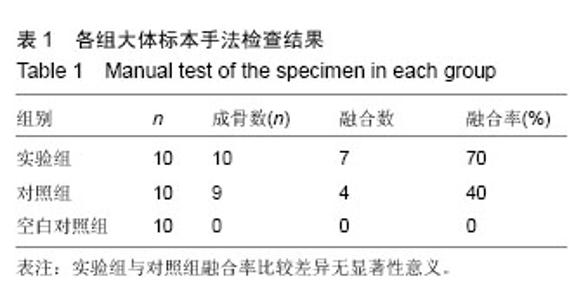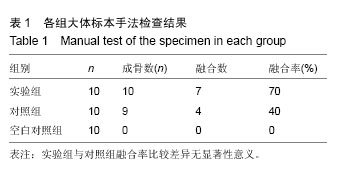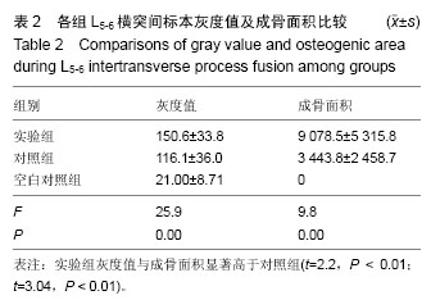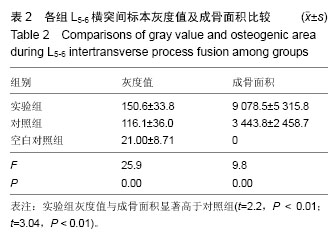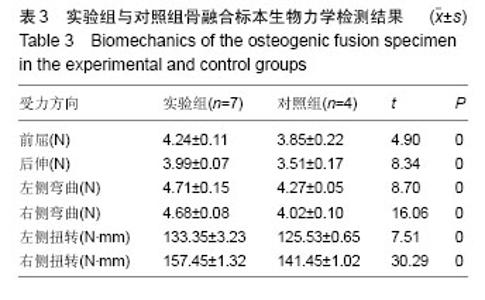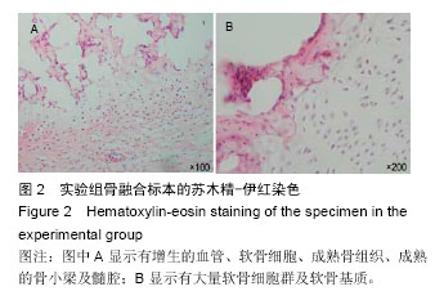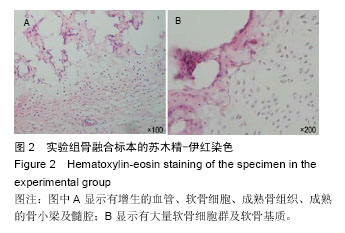Chinese Journal of Tissue Engineering Research ›› 2016, Vol. 20 ›› Issue (25): 3699-3705.doi: 10.3969/j.issn.2095-4344.2016.25.008
Previous Articles Next Articles
Fibrin glue combined with vascular endothelial growth factor and recombinant human bone morphogenetic protein 2 applied in spinal fusion
Tian Ye1, Zhu Yue2, Zhong Tao3
- 1Department of Orthopaedics, Red Cross Hospital of Shenyang, Shenyang 110013, Liaoning Province, China; 2Department of Orthopaedics, the First Affiliated Hospital of China Medical University, Shenyang 110013, Liaoning Province, China; 3Department of Orthopaedics, the Third Hospital of Dalian, Dalian 116003, Liaoning Province, China
-
Received:2016-03-25Online:2016-06-17Published:2016-06-17 -
Contact:Zhu Yue, Department of Orthopaedics, the First Affiliated Hospital of China Medical University, Shenyang 110013, Liaoning Province, China -
About author:Tian Ye, Master, Associate chief physician, Department of Orthopaedics, Red Cross Hospital of Shenyang, Shenyang 110013, Liaoning Province, China
CLC Number:
Cite this article
Tian Ye, Zhu Yue, Zhong Tao. Fibrin glue combined with vascular endothelial growth factor and recombinant human bone morphogenetic protein 2 applied in spinal fusion[J]. Chinese Journal of Tissue Engineering Research, 2016, 20(25): 3699-3705.
share this article
| [1] Younger EM,Chapman MW.Morbidity at bone graft donor site.Orthorp Trauma.1989;3:192-195.[2] Gerstenfed LC,Cullinanes DM,Barnes GL.Fracture healing as a postnatal developmental process: molecular,spatial,and temporal aspects of its regulation.J Cell Biochem.2003;88:873-884.[3] Suárez-González D, Lee JS, Diggs A,et al. Controlled multiple growth factor delivery from bone tissue engineering scaffolds via designed affinity.Tissue Eng Part A.2014; 20(15-16):2077-2087.[4] Samee M,Kasugai S,Kondo H,et al.Bone morphogenetic protein-2 (BMP-2) and vascular endothelial growth factor (VEGF) transfection to human periosteal cells enhances osteoblast differentiation and bone formation.J Pharmacol Sci. 2008;108(1):18-31. [5] Peng H,Wright V,Usas A,et al.Synynergistic enhancement of bone formation and healing by stem cell-expressed VEGF and bone morphogenetic protein-4.J Clin Invest. 2002;110(6):751-759.[6] Kawamura M,Urist MR.Human fibrin is a physiological delivery system for bone morphogenetic protein.Clin Orthop.1988;235:302-310. [7] Mandracchia VJ,Nelson SL,Barp EA.Current concepts of bone healing.Clin Podiatr Med Surg. 2001;18:55-77.[8] David SM,Gruber HE,Meyer RA.Lumbar spine fusion using recombinant human bone morphogenetic protein in the canine.Spine (Phila Pa 1976). 1999;24: 1973-1979.[9] Laffargue P,Hildebrand HF,Rtaimate M.Evaluation of human recombinant bone morphogenetic protein-2-loaded tricalcium phosphate implants in rabbits' bone defects.Bone.1999;25(2 Suppl):55S-58S.[10] Irie K,Alpaslan C,Takahashi K. Osteoclast differentiation in ectopic bone formation induced by recombinant human bone morphogenetic protein 2 (rhBMP-2).J Bone Miner Metab. 2003;21(6):363-369.[11] Schimandle JH,Boden SD,Hutton WC.Experimental spinal fusion with recombinant human bone morphogenetic protein-2.Spine (Phila Pa 1976). 1995; 20(12):1326-337. [12] Boden SD,Schimandle JH,Hutton WC.1995 Volvo Award in basic sicences:The use of an osteoinductive growth factor for lumbar spinal fusion.Part Il:Study of dose,carrier,and species.Spine (Phila Pa 1976).1995; 20(24):2633-2644. [13] Morone MA,Boden SD,Hair G,et a1.Gene expression during autograft lumbar spine fusion and the effect of bone morphogenetic protein-2.Clin Orthop. 1998;351: 252-265.[14] Park DK,Kim SS,Thakur N,et al.Use of recombinant human bone morphogenetic protein-2 with local bone graft instead of iliac crest bone graft in posterolateral lumbar spine arthrodesis.Spine (Phila Pa 1976). 2013; 38(12):E738-747.[15] Barnes B,Boden SD,Louis-Ugbo J,et al.Lower dose of rhBMP-2 achieves spine fusion when combined with an osteoconductive bulking agent in non-human primates.Spine (Phila Pa 1976).2005;30(10): 1127-1133.[16] Glowacki J.Angiogenesis in fracture repair.Clin Orthop. 1998;355(Suppl.):S82-89.[17] Nakagawa M,Kaneda T,Arakawa T.Vascular endothelial growth factor(VEGF) directly enhence osteoclastic bone resorption and survial mature osteoclasts.FEBS Lett.2000;4473:161-164.[18] Gerber HP,Vu TH,Ryan AM,et al.VEGF couples hypertrophic cartilage remodeling,ossification and angiogenesis during endochondral bone formation.Nat Med.1999;5:623-628. [19] Street J,Bao M,deGuzman L,et al.Vascular endothelial growth factor stimulate bone repair by promoting angiogenesis bone turnover.Proc Netl Sci USA. 2002; 99(15): 9656-9661.[20] Streeten EA,Brandi ML.Biology of bone endothelial cells.Bone Miner.1990;10:85-94. [21] Wang S,Miura M,Demura H,et al.Anablic effects of 1,25-dihydroxyvitamin D3 on osteoblasts are enhanced by vascular endothelial growth factor produced by osteoblasts and by growth factors produced by endothelial cells.Endocrinology. 1997; 138:2953-2962.[22] Nakagawa M,Kaneda T,Arakawa T.Vascular endothelial growth factor(VEGF) directly enhence osteoclastic bone resorption and survial mature osteoclasts.FEBS Lett.2000;4473:161-164.[23] Niida S,Kaku M,Amano H.Vascular endothelial growth factor can substitude for macrophage colony-stimulating factor in the support of osteoclastic bone resorption.J Exp Med.1999;190:293-298.[24] Street J,Winter D,Wang JH,Wakai A.Is human fracture hematoma inherently angiogenic? Clin Orthop Relat Res. 2000;(378):224-237.[25] Peng H,Wright V,UsasA,et al.Synynergistic enhancement of bone formation and healing by stem cell-expressed VEGF and bone morphogenetic protein-4.J Clin Invest.2002; 110(6):751-759. [26] Xiao C,Zhou H,Liu G,et al.Bone marrow stromal cells with a combined expression of BMP-2 and VEGF-165 enhanced bone regeneration.Biomed Mater. 2011; 6(1):015013.[27] Sukul M,Nguyen TB,Min YK,et al.Effect of Local Sustainable Release of BMP2-VEGF from Nano-Cellulose Loaded in Sponge Biphasic Calcium Phosphate on Bone Regeneration. Tissue Eng Part A.2015;21(11-12):1822-3186.[28] Hay E,Lemonnier J,Fromigue O.Bone morphogenetic protein-2 promotes osteoblast apoptosis through a Smad-independent,protein kinase C-dependent signaling pathway.J Biol Chem.2001;276: 29028- 29036.[29] Bouletreau PJ,Warren SM,Spector JA,et al.Hypoxia and VEGF up-regulate BMP-2 mRNA and protein expression in microvascular endothelial cells: implications for fracture healing.Plast Reconstr Surg. 2002;109(7):2348.[30] Deckers MM,van Benzoonijen RL,van der Horst G,et al.Bone morphogenetic proteins stimulate angiogenesis through osteoblast-derived vascular endothelial growth factor A.Endocrinology. 2002;143(4): 1545-553. [31] Matsubara H,Hogan DE,Morgan EF,et al.Vascular tissues are a primary source of BMP2 expression during bone formation induced by distraction osteogenesis. Bone.2012;51(1):168-180. [32] Zhang G,Drinnan CT,Geuss LR,et al.Vascular differentiation of bone marrow stem cells is directed by a tunable three-dimensional matrix.Acta Biomater. 2010;6(9):3395-403. [33] Ohira S,Doi K,Yaku H.Sutureless Technique to Fix the Great Saphenous Vein along the Atrioventricular Groove Using Fibrin Glue in Off-Pump Coronary Artery Bypass Grafting.Heart Surg Forum. 2016;19(2): E074-076. [34] Sakaguchi Y,Tsuji Y,Fujishiro M,et al.Triamcinolone Injection and Shielding with Polyglycolic Acid Sheets and Fibrin Glue for Postoperative Stricture Prevention after Esophageal Endoscopic Resection: A Pilot Study.Am J Gastroenterol.2016;111(4):581-583. [35] Hong KP,Kim DK,Kang KH.Staple Line Coverage with a Polyglycolic Acid Patch and Fibrin Glue without Pleural Abrasion after Thoracoscopic Bullectomy for Primary Spontaneous Pneumothorax.Korean J Thorac Cardiovasc Surg.2016;49(2):85-91. [36] Liu Z,Zhu Y,Zhu H,et al.Enhancement of posterolateral lumbar spine fusion using recombinant human bone morphogenetic protein-2 and mesenchymal stem cells delivered in fibrin glue.J Biomater Appl.2016.pii: 0885328216643854.[Epub ahead of print][37] Cho AB,Paulos RG,Bersani G,et al.A reinforcement of the sutured microvascular anastomosis with fibrin glue application: A retrospective comparative study with the standard conventional technique.Microsurgery. 2016.doi:10.1002/micr.30054.[Epub ahead of print] |
| [1] | Zhang Tongtong, Wang Zhonghua, Wen Jie, Song Yuxin, Liu Lin. Application of three-dimensional printing model in surgical resection and reconstruction of cervical tumor [J]. Chinese Journal of Tissue Engineering Research, 2021, 25(9): 1335-1339. |
| [2] | Zeng Yanhua, Hao Yanlei. In vitro culture and purification of Schwann cells: a systematic review [J]. Chinese Journal of Tissue Engineering Research, 2021, 25(7): 1135-1141. |
| [3] | Xu Dongzi, Zhang Ting, Ouyang Zhaolian. The global competitive situation of cardiac tissue engineering based on patent analysis [J]. Chinese Journal of Tissue Engineering Research, 2021, 25(5): 807-812. |
| [4] | Wu Zijian, Hu Zhaoduan, Xie Youqiong, Wang Feng, Li Jia, Li Bocun, Cai Guowei, Peng Rui. Three-dimensional printing technology and bone tissue engineering research: literature metrology and visual analysis of research hotspots [J]. Chinese Journal of Tissue Engineering Research, 2021, 25(4): 564-569. |
| [5] | Chang Wenliao, Zhao Jie, Sun Xiaoliang, Wang Kun, Wu Guofeng, Zhou Jian, Li Shuxiang, Sun Han. Material selection, theoretical design and biomimetic function of artificial periosteum [J]. Chinese Journal of Tissue Engineering Research, 2021, 25(4): 600-606. |
| [6] | Liu Fei, Cui Yutao, Liu He. Advantages and problems of local antibiotic delivery system in the treatment of osteomyelitis [J]. Chinese Journal of Tissue Engineering Research, 2021, 25(4): 614-620. |
| [7] | Li Xiaozhuang, Duan Hao, Wang Weizhou, Tang Zhihong, Wang Yanghao, He Fei. Application of bone tissue engineering materials in the treatment of bone defect diseases in vivo [J]. Chinese Journal of Tissue Engineering Research, 2021, 25(4): 626-631. |
| [8] | Zhang Zhenkun, Li Zhe, Li Ya, Wang Yingying, Wang Yaping, Zhou Xinkui, Ma Shanshan, Guan Fangxia. Application of alginate based hydrogels/dressings in wound healing: sustained, dynamic and sequential release [J]. Chinese Journal of Tissue Engineering Research, 2021, 25(4): 638-643. |
| [9] | Chen Jiana, Qiu Yanling, Nie Minhai, Liu Xuqian. Tissue engineering scaffolds in repairing oral and maxillofacial soft tissue defects [J]. Chinese Journal of Tissue Engineering Research, 2021, 25(4): 644-650. |
| [10] | Xing Hao, Zhang Yonghong, Wang Dong. Advantages and disadvantages of repairing large-segment bone defect [J]. Chinese Journal of Tissue Engineering Research, 2021, 25(3): 426-430. |
| [11] | Tang Xiaokai, Li Weiming. Role and mechanism of Nel-like molecule-1 in promoting bone fusion after spinal fusion [J]. Chinese Journal of Tissue Engineering Research, 2021, 25(24): 3914-3920. |
| [12] | Chen Siqi, Xian Debin, Xu Rongsheng, Qin Zhongjie, Zhang Lei, Xia Delin. Effects of bone marrow mesenchymal stem cells and human umbilical vein endothelial cells combined with hydroxyapatite-tricalcium phosphate scaffolds on early angiogenesis in skull defect repair in rats [J]. Chinese Journal of Tissue Engineering Research, 2021, 25(22): 3458-3465. |
| [13] | Wang Hao, Chen Mingxue, Li Junkang, Luo Xujiang, Peng Liqing, Li Huo, Huang Bo, Tian Guangzhao, Liu Shuyun, Sui Xiang, Huang Jingxiang, Guo Quanyi, Lu Xiaobo. Decellularized porcine skin matrix for tissue-engineered meniscus scaffold [J]. Chinese Journal of Tissue Engineering Research, 2021, 25(22): 3473-3478. |
| [14] | Mo Jianling, He Shaoru, Feng Bowen, Jian Minqiao, Zhang Xiaohui, Liu Caisheng, Liang Yijing, Liu Yumei, Chen Liang, Zhou Haiyu, Liu Yanhui. Forming prevascularized cell sheets and the expression of angiogenesis-related factors [J]. Chinese Journal of Tissue Engineering Research, 2021, 25(22): 3479-3486. |
| [15] | Liu Chang, Li Datong, Liu Yuan, Kong Lingbo, Guo Rui, Yang Lixue, Hao Dingjun, He Baorong. Poor efficacy after vertebral augmentation surgery of acute symptomatic thoracolumbar osteoporotic compression fracture: relationship with bone cement, bone mineral density, and adjacent fractures [J]. Chinese Journal of Tissue Engineering Research, 2021, 25(22): 3510-3516. |
| Viewed | ||||||
|
Full text |
|
|||||
|
Abstract |
|
|||||
